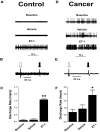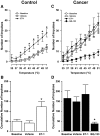Tumor-evoked sensitization of C nociceptors: a role for endothelin
- PMID: 18684911
- PMCID: PMC2576210
- DOI: 10.1152/jn.01337.2007
Tumor-evoked sensitization of C nociceptors: a role for endothelin
Abstract
Primary and metastatic cancers that effect bone are frequently associated with pain. Sensitization of primary afferent C nociceptors innervating tissue near the tumor likely contributes to the chronic pain and hyperalgesia accompanying this condition. This study focused on the role of the endogenous peptide endothelin-1 (ET-1) as a potential peripheral algogen implicated in the process of cancer pain. Electrophysiological response properties, including ongoing activity and responses evoked by heat stimuli, of C nociceptors were recorded in vivo from the tibial nerve in anesthetized control mice and mice exhibiting mechanical hyperalgesia following implantation of fibrosarcoma cells into and around the calcaneus bone. ET-1 (100 microM) injected into the receptive fields of C nociceptors innervating the plantar surface of the hind paw evoked an increase in ongoing activity in both control and tumor-bearing mice. Moreover, the selective ETA receptor antagonist, BQ-123 (3 mM), attenuated tumor-evoked ongoing activity in tumor-bearing mice. Whereas ET-1 produced sensitization of C nociceptors to heat stimuli in control mice, C nociceptors in tumor-bearing mice were sensitized to heat, and their responses were not further increased by ET-1. Importantly, administration of BQ-123 attenuated tumor-evoked sensitization of C nociceptors to heat. We conclude that ET-1 at the tumor site contributes to tumor-evoked excitation and sensitization of C nociceptors through an ETA receptor mediated mechanism.
Figures




References
-
- Amaya F, Decosterd I, Samad TA, Plumpton C, Tate S, Mannion RJ, Costigan M, Woolf CJ. Diversity of expression of the sensory neuron-specific TTX-resistant voltage-gated sodium ion channels SNS and SNS2. Mol Cell Neurosci 15: 331–342, 2000. - PubMed
-
- Arai H, Hori S, Aramori I, Ohkubo H, Nakanishi S. Cloning and expression of a cDNA encoding an endothelin receptor. Nature 348: 730–732, 1990. - PubMed
-
- Baamonde A, Lastra A, Villazon M, Bordallo J, Hidalgo A, Menendez L. Involvement of endogenous endothelins in thermal and mechanical inflammatory hyperalgesia in mice. Naunyn Schmiedebergs Arch Pharmacol 369: 245–251, 2004. - PubMed
-
- Balonov K, Khodorova A, Strichartz GR. Tactile allodynia initiated by local subcutaneous endothelin-1 is prolonged by activation of TRPV-1 receptors. Exp Biol Med 231: 1165–1170, 2006. - PubMed
-
- Banik RK, Kozaki Y, Sato J, Gera L, Mizumura K. B2 receptor-mediated enhanced bradykinin sensitivity of rat cutaneous C-fiber nociceptors during persistent inflammation. J Neurophysiol 86: 2727–2735, 2001. - PubMed
Publication types
MeSH terms
Substances
Grants and funding
LinkOut - more resources
Full Text Sources
Other Literature Sources

